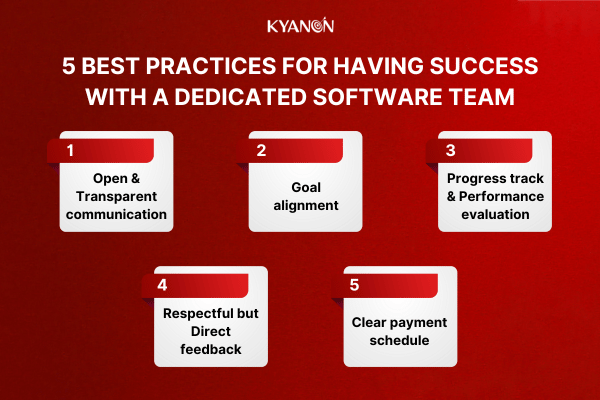A dedicated software development team is a group of specialists in developing, operating, or maintaining software according to client requirements. It typically consists of 7 key roles, including a project manager, business analyst, product owner, UI/UX designer, software developer, QA engineer, and DevOps engineer. Having a dedicated software development team is similar to building a temporary in-house team. It allows companies to get access to the skills of industry experts, and at the same time, eliminates the costs of hiring and training an in-house team and all the fixed costs associated with office space, equipment, etc. Besides, it is the optimal solution for firms under strict deadlines to keep up with competition in their industry and for start-ups looking to boost their growth but not having the resources to do so.
However, there are pitfalls that companies need to be aware of when hiring a dedicated software team, such as misunderstandings due to communication barriers, poor performance due to loose control, etc. In this article, Kyanon Digital will help you explore the 5 best practices for having success with a dedicated software development team.

1. Open and Transparent Communication
Open and transparent communication is crucial in fostering mutual understanding and ensuring smooth cooperation between two parties. However, there are factors that hinder effective communication.
1.1. Communication Barriers
First of all, as technology advances promote cross-border trade, software development offshoring becomes popular for those seeking low-cost but high-quality software solutions. Apart from the obvious advantages, cultural differences could pose challenges in communication. It would be worth noting that although cultural globalization is rising and the ways of doing business are increasingly standardized worldwide, subtle cultural differences still exist and need to be taken into account. For instance, implicit meanings in the words of Eastern businesspeople may not be discovered and fully understood by those in Western culture. Even worse, virtual collaboration, in the absence of in-person connections and body language, could further exacerbate the difficulties of working in international teams.
Second, technical issues can be another problem. Let us take an example, a project involves an account and technical team from each party. Different departments and organizations speak different languages and they have their own ways of doing things. Misunderstandings now not only come from the two organizations but also from within your own firm. Therefore, open communication and easy-to-understand language is extremely important to ensure everyone is on the same page.
1.2. Fostering Open Communication
To overcome the communication barriers, it is important to use explicit language so that everyone can understand. Besides, it would be useful to refrain from using highly specialized terms and be comfortable with giving further explanations if anyone is not clear. Moreover, choosing the right communication channel is also important. A good channel should be accessible to all people involved so that they can be quickly informed about updates or any possible changes. The official communication channel should also be separated from informal platforms that are mainly used for entertaining purposes, such as Messenger. Furthermore, it is advisable to avoid creating too many small chat groups. The more layers of information dissemination, the more likely the information is deviated from its original meaning.

2. Goal Alignment
Aligning your goals with the outsourced team is critical to keeping everyone on the same track. Besides, when goals are aligned, collaboration is enhanced because everyone speaks the same language. This would also make your dedicated team more accountable, which helps reduce your time and efforts for closely monitoring them as well as shortening lengthy meetings for getting them back on track. More importantly, having facilitated open communication, your team and the dedicated software development team are more likely to build mutual trust. And together with mutual trust, ensuring goal alignment can encourage innovative thinking and drive initiatives towards desired outcomes for both parties, as stated by Deloitte in the Global Outsourcing Survey 2022.
To promote goal alignment, you need to know your needs and clearly define your goals. Then, you should briefly explain your business problems and clearly communicate your objectives with the dedicated software development team by specifying your desired results, including what to achieve and how much to achieve. Establishing your expectations with the outsourced team is essential to get the right personnel and resources allocated for your project. Scope of work and timelines should also be defined. Scope of work templates could be useful references to check for possible missed elements.

3. Progress Track and Performance Evaluation
Next, progress tracking is a powerful tool that helps keep your project moving forward. You need to set up clear evaluation metrics and share them with the outsourced team. These metrics serve as benchmarks for objective performance assessment and for the dedicated team to focus their efforts on the right thing. Additionally, it would be useful to break down your project into smaller and achievable milestones, especially for complex projects. Not only does this give the dedicated software development team a better understanding of the overall project and a glance of all the tasks they will need to do, but it also provides you a mechanism to better oversee the project. Also, regular project updates are necessary to ensure that deliverables are aligned with the intended results and that they can be brought back into alignment if necessary. Besides, report channels and who to report to should be officially chosen to keep report records in one centralized platform and keep certain people responsible for specific areas.

4. Respectful but Direct Feedback
Respectful and direct feedback is crucial for maintaining a positive and productive working relationship between you and the outsourced team. First, the dedicated software development team is not only a service provider. They are your partner and their output quality could have a decisive impact on your business. The outsourcing project is a win-win situation for both parties. Therefore, showing your respect is of significant importance for effective collaboration. Together with showing respect, direct feedback is equally important because it provides clear and specific information about what needs to be improved.
Here are some guidelines on how to give feedback effectively:
- Be specific: Go straight to the point and specify areas for adjustments
- Be timely: Give feedback as soon as errors or misalignments are identified to avoid wasting time on keeping doing the tasks wrongly
- Focus on the task at hand, not the individual: Feedback is used to identify areas for improvement and give actionable suggestions, not to criticize the person doing the task. Leave out personal judgements and focus on addressing the bottlenecks
- Facilitate two-way communication: Effective feedback is never one-way. The purpose is to form mutual understanding between two parties and allow time for the two parties to work together to find better solutions. Therefore, the outsourced team members should be encouraged to speak up, ask for clarification, or propose their solutions to achieve the common goals.

5. Clear Payment Schedule
A payment schedule, including the amounts due, payment due dates, payment methods, etc., needs to be negotiated and clearly specified before the start of the project. Late payments can cause delays in the project timeline and slow down progress, thus decreasing morale of the people involved and lowering efficiency. Therefore, issues relating to payment need to be transparent.

Kyanon Digital is a tech powerhouse based in Vietnam and Singapore and is a leading provider of software outsourcing solutions. Vietnam’s IT workforce is advancing rapidly and receiving worldwide attention. If you want to leverage the benefits of this dynamic and potential workforce, contact us for advice from leading experts in the industry.



